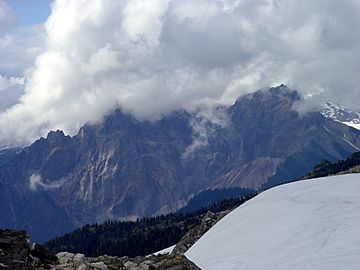Pyroclastic Peak facts for kids
Quick facts for kids Pyroclastic Peak |
|
|---|---|

South face of Pyroclastic Peak
|
|
| Highest point | |
| Elevation | 2,349 m (7,707 ft) |
| Prominence | 145 m (476 ft) |
| Geography | |
| Location | British Columbia, Canada |
| Parent range | Pacific Ranges |
| Topo map | NTS 92J/03 |
| Geology | |
| Age of rock | Pleistocene |
| Mountain type | Stratovolcano |
| Volcanic arc/belt | Canadian Cascade Arc Garibaldi Volcanic Belt |
| Last eruption | Pleistocene |
| Climbing | |
| First ascent | 1971 R. Chicoine; F. Douglas; R. Wyborn |
Pyroclastic Peak is a mountain in British Columbia, Canada. It is known for being a volcanic peak. This means it was formed by ancient volcanic eruptions.
The peak is located about 12 kilometers (7.5 miles) southwest of Callaghan Lake. It is also about 24 kilometers (15 miles) west of Whistler. Pyroclastic Peak is the second highest of five volcanic peaks near Mount Cayley.
Contents
About Pyroclastic Peak
Pyroclastic Peak stands tall at 2,349 meters (7,707 feet) above sea level. It is part of the Pacific Ranges mountain chain. The mountain's name comes from "pyroclastic" material. This is a type of rock made from volcanic ash and fragments.
Location and Neighbors
Pyroclastic Peak is found in a beautiful part of Canada. It is in the province of British Columbia. The mountain is part of the Garibaldi Volcanic Belt. This belt is a chain of volcanoes. It stretches across southwestern British Columbia.
The peak is close to other famous mountains. These include Mount Cayley. The area is known for its rugged and wild landscape. It is a popular spot for outdoor adventures.
A Volcanic Mountain
Pyroclastic Peak is a Stratovolcano. This type of volcano is also called a composite volcano. They are known for their cone shape. This shape is built up over many eruptions. Each eruption adds layers of lava, ash, and rock.
What is a Stratovolcano?
Stratovolcanoes are often very tall and steep. They have a crater at the top. The lava that flows from them is usually thick. This thick lava cools quickly. It builds up the steep sides of the volcano.
Pyroclastic Peak last erupted a very long time ago. This was during the Pleistocene epoch. The Pleistocene epoch was a period of Earth's history. It lasted from about 2.6 million to 11,700 years ago.
Part of the Ring of Fire
Pyroclastic Peak is part of the Pacific Ring of Fire. This is a huge area around the Pacific Ocean. It has many active volcanoes and earthquake zones. The Ring of Fire includes over 160 active volcanoes.
The Ring of Fire is shaped like a horseshoe. It stretches for about 40,000 kilometers (25,000 miles). It is where many of Earth's tectonic plates meet. These plates are huge pieces of Earth's crust. When they move, they cause volcanoes and earthquakes.
The Vulcan's Thumb
On the south side of Pyroclastic Peak, there is a unique rock formation. It is called The Vulcan's Thumb. This feature looks like a giant thumb sticking up. It is a very striking sight.
The Vulcan's Thumb is known for its loose rock. This makes it very difficult to climb. In fact, it remains unclimbed by mountaineers. The rock is so unstable that it is too dangerous to attempt.
Formation and Geology
The rocks that make up Pyroclastic Peak are quite old. They formed during the Pleistocene epoch. The mountain's steep sides are a result of its volcanic past. The layers of ash and lava built up over time.
How Volcanoes Form Mountains
Volcanoes like Pyroclastic Peak form when magma rises from deep inside the Earth. Magma is molten rock. When it reaches the surface, it becomes lava. The lava, ash, and rocks pile up. This creates the cone shape of a volcano. Over many eruptions, these piles grow into mountains.
"Rotten" Rock Explained
The term "rotten" rock is used to describe the mountain's surface. This means the rock is weak and crumbly. It breaks apart easily. This can happen due to weathering over thousands of years. It also happens because of the way the volcanic rock formed. This makes climbing very challenging and risky.

